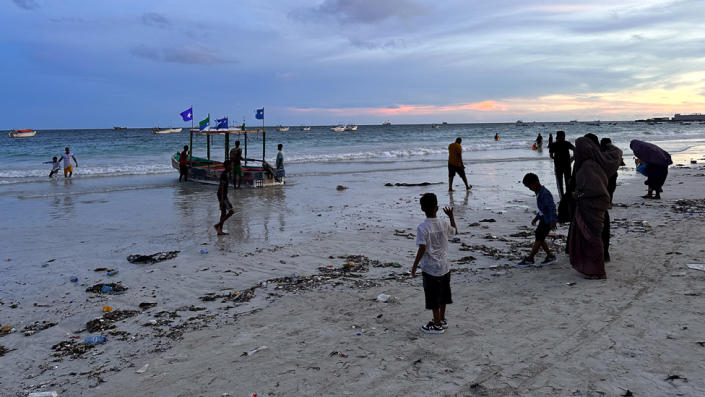
In our series of letters from African journalists, Soraya Ali attempts to reconcile the idyllic image of Somalia she grew up with and its reputation as a hostile place.

Until a few weeks ago, I had never come home.
A country whose language I speak and resemble everyone else, but where I have never set foot.
That place is Somalia.
But this month, I followed in the footsteps of countless children in the diaspora and booked a one-way ticket home.
I was born and raised in London, some 6,000 miles (9,700 km) from my family’s roots.
Growing up, I always felt torn between the idea of what felt like two very different cities.
I would hear about Mogadishu on the news. A capital full of death and destruction, presented as “the most dangerous place in the world”.
But then my parents spoke so fondly of “Xamar”, as the locals call it. They described a beautiful city, located on the longest coastline in Africa, known to many as “the pearl of the Indian Ocean”.
I realized that both versions contain some truth.

Many Africans in the diaspora, like me, have returned to their original or ancestral homelands.
On arrival, there is often a deep sense of belonging, but at the same time, a melancholy about the differences that belonging to the diaspora has created.
My parents were born in Mogadishu in the late 1950s, and like many older Somalis, they have rosy memories of the country.
“We used to zoom around in our convertibles and wear whatever we wanted,” my mom often recalled, recalling her wild adventures and even crazier hairstyles. Nowadays, women are expected to dress more conservatively.
“All you had was goats,” my siblings tease, much to his dismay.
The Somalia we grew up seeing on our screens showed Western journalists in camps for displaced people talking to people on the brink of starvation. In the 1990s, it was because of the war.
But the same images are shown, in 2023, due to ongoing instability and climate change.
Unexpectedly, the most accurate picture of Somalia I got was via TikTok.
#SomaliTikTok is huge and the hashtag has amassed some 77 billion views.
Through social media, I got a glimpse of daily life in Mogadishu, through the lens of locals and people like me. This pushed me to go see it with my own eyes and even to consider settling here.

Of course Mogadishu is still a dangerous place, the al-Qaeda affiliated al-Shabab remains an active threat. An attack in October killed more than 100 people.
But there’s another side to the city that’s rarely shown – fear of instability means most Westerners don’t travel freely.
The only white face I’ve seen is within the limits of the high security airport village.
But the true essence of Mogadishu can only be discovered through its restaurants, markets, beaches and people.
The city comes alive at night and is best explored on a bajaja – a Somali rickshaw.
“There are six bajajas for each person,” one driver joked.
Familiar foods and flavors remind me of my mother’s cooking.
African staples like meat and rice are still served with fresh bananas, along with dishes like spicy spaghetti Bolognese, from the country’s Italian colonial past.
Local fishermen carry a giant rare tuna on their shoulders, worth tens of thousands of dollars in Japan.
Unfortunately, the lack of infrastructure and investment in the country’s once fledgling fishing industry means they rarely reap the rewards.
But as President Hassan Sheik Mohamud spends a year in power, there is a growing sense that the country is on the road to reconstruction.

“You see construction everywhere, we are slowly improving, God willing,” my 24-year-old bajaja driver points out.
Like many, he has yet to experience a stable Somalia. War broke out in 1991 and about 75% of the country’s population is under 30 years old.
He remains optimistic but our conversation highlights the glaring inequality.
Like many in the diaspora, I have the privilege of choosing to return.
While other Somalis, especially those outside the capital, are looking for a way out.
In 2022, Somalia had the eighth highest number of refugees in the world, according to the United Nations.
Somalia is one of the most climate-vulnerable countries in the world and extreme weather events have forced hundreds of thousands of people from their homes, with the worst drought in 40 years now giving way to flash floods.
As we move through the city, I notice the buildings, new and old, and admire the Afro-Italian Islamic architecture.
They are fortified behind concrete barriers and piles of sandbags. And on almost every corner of town is a young officer armed with an AK-47 rifle.
Calls to prayer are broadcast over loudspeakers and interspersed with the sound of distant gunfire.
Despite this, I feel a deep hope. And I’m not alone.
The city is filled with other diasporas, often from Minnesota or Toronto, as well as local Somalis determined to cultivate stability.
“I believe in my country,” a young businesswoman tells me.
She says she never wants to leave.
“We can bring back the Somalia our parents told us about,” she adds.
More letters from Africa:
Follow us on twitter @BBCAfricaon Facebook at BBC Africa or on Instagram at bbcafrica


